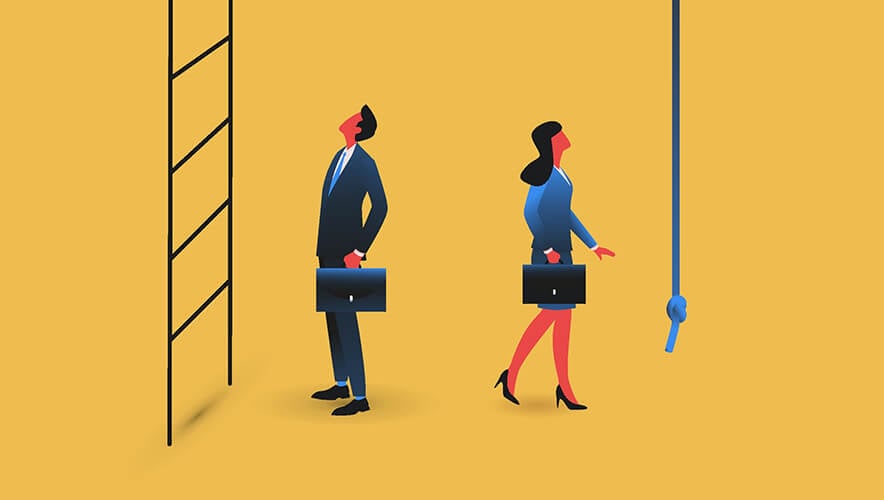UN Report: Biased Gender Social Norms Continue to Undervalue Women
Despite calls for universal gender equity, a new report shows that society has made very little progress in the last 10 years in addressing gender biases.
The finding comes from the United Nations Development Program's 2023 Gender Social Norms Index, which quantifies the ways societal attitudes foster gender inequity and reinforce biases that limit the opportunities available to women.
Overall, researchers found that 88.7 percent of people hold at least one biased belief. When broken out by gender, researchers found that 87.3 percent of women hold at least one bias.
Additional sobering statistics: almost 50 percent of people think men make better politicians than women, and 43 percent of people think men make better business executives than women. The report says these attitudes have become manifest with only 10 percent of countries having women as the head of government and only 28 percent of worldwide managerial positions being held by women.
Particularly alarming, 25 percent of people believe there can be justification for a husband to beat his wife.
Breaking Down the Data
The report used data from the massive U.N. World Values Survey Waves 6 (data from 2010-2014) and 7 (data from 2017 to 2021). Wave 7 included data from 80 countries covering 85 percent of the world’s population. It categorized gender attitudes into four dimensions: political, educational, economic, and physical integrity.
Furthermore, the study shows that these attitudes have proven stubbornly persistent. Comparing Wave 6 to Wave 7 data, in the countries that were part of both surveys, the overall share of the population that held at least one bias decreased by just 2.3 percent over the 10-year span.
Another common misconception, the report says, is that there will be a major difference in highly developed countries compared to less developed countries. But the report shows that biases are pervasive throughout. Only nine of the 80 countries in the survey have a population that is less than 50 percent biased; not the United States (50.22 percent), South Korea (89.88 percent), or France (56.47 percent). Even in the country with the least gender bias—New Zealand—more than one in four people harbor some gender bias.
As already mentioned, one of the report’s conclusions is that biased gender social norms discourage or prevent women from becoming leaders.
“Social norms that inhibit women’s representation in decision making deprive societies of the many benefits of women’s leadership and of diversity of perspectives, experiences, abilities, voices, and ideas,” according to the report.
How Progress is Made
While little progress on gender bias has been made overall, the report notes there is evidence that progress can be made. Several countries have seen dramatic improvement in addressing gender bias.
In Germany, for example, 20 percent fewer people had bias when comparing Wave 6 and Wave 7 data. Uruguay improved by more than 15 percent, and Brazil, The Netherlands, and the United States all improved by at least 5 percent.
The report notes that changing the norms that underly biases is complex, difficult, and often precipitated by events where societal changes are best measured in decades.
For example, the advent of the birth control pill had major implications that are still unfolding 60 years later. Another societal change with major implications is the worldwide movement toward compulsory education for all children through eighth grade. And when women engage in leadership roles in politics and business, it has beneficial effects on future generations, according to the UN's analysis.
One statistic in the report serves both to showcase the problem and the potential: In 2023, just 10 percent of U.S. Fortune 500 company CEOs are women. But this also represents marked improvement from 2010 when 3 percent of these positions were held by women.
And while the report notes progress is possible, the stubborn persistence of societal norms means real, significant, worldwide change is glacial. For the Germany, Uruguay, and New Zealand success stories, there are plenty of backsliding countries. The percent of people showing gender bias in Chile, for instance, has increased by more than 5 percent, followed closely by South Korea.
Even when all legal barriers have been removed and trailblazers have shown women can achieve success, “the gender-based biases we carry into voting booths, board meetings, interview panels, and assemblies present barriers to women’s ability to fulfil their full potential,” the report says. “Policies to achieve comprehensive gender equality have to be designed and implemented to address biased gender social norms.”
Results by Country
The following are results for selected countries. Individual results for any of the countries in the study is available on the U.N. Development Program website.
Least biased: New Zealand
|
Men with at least one bias indicator |
33% |
|
Women with at least one bias indicator |
23% |
|
Show political bias |
15% |
|
Show education bias |
3% |
|
Show economic bias |
9% |
|
Show physical integrity bias |
14% |
Most biased: Pakistan
|
Men with at least one bias indicator |
100% |
|
Women with at least one bias indicator |
100% |
|
Show political bias |
86% |
|
Show education bias |
60% |
|
Show economic bias |
92% |
|
Show physical integrity bias |
92% |
Other selected countries:
United States
|
Men with at least one bias indicator |
32% |
|
Women with at least one bias indicator |
27% |
|
Show political bias |
21% |
|
Show education bias |
3% |
|
Show economic bias |
10% |
|
Show physical integrity bias |
8% |
Australia
|
Men with at least one bias indicator |
43% |
|
Women with at least one bias indicator |
29% |
|
Show political bias |
23% |
|
Show education bias |
3% |
|
Show economic bias |
13% |
|
Show physical integrity bias |
17% |
Brazil
|
Men with at least one bias indicator |
85% |
|
Women with at least one bias indicator |
84% |
|
Show political bias |
40% |
|
Show education bias |
10% |
|
Show economic bias |
31% |
|
Show physical integrity bias |
76% |
Canada
|
Men with at least one bias indicator |
48% |
|
Women with at least one bias indicator |
34% |
|
Show political bias |
28% |
|
Show education bias |
7% |
|
Show economic bias |
16% |
|
Show physical integrity bias |
24% |
Germany
|
Men with at least one bias indicator |
42% |
|
Women with at least one bias indicator |
33% |
|
Show political bias |
13% |
|
Show education bias |
4% |
|
Show economic bias |
15% |
|
Show physical integrity bias |
23% |
Japan
|
Men with at least one bias indicator |
64% |
|
Women with at least one bias indicator |
54% |
|
Show political bias |
39% |
|
Show education bias |
14% |
|
Show economic bias |
37% |
|
Show physical integrity bias |
25% |
United Kingdom
|
Men with at least one bias indicator |
32% |
|
Women with at least one bias indicator |
27% |
|
Show political bias |
21% |
|
Show education bias |
3% |
|
Show economic bias |
10% |
|
Show physical integrity bias |
8% |
For more on the intersection of gender equity and security, check out "Where Does DE&I Stand in the Security Industry?," "One in Five Workers Worldwide Has Experience Workplace Violence or Harassment," and "Diversity, Equity, and Inclusion in Physical Security: Why it Matters."












